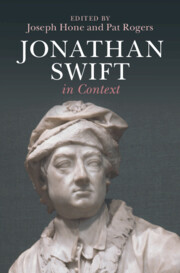Book contents
- Jonathan Swift in Context
- Jonathan Swift in Context
- Copyright page
- Contents
- Notes on Contributors
- Preface
- Acknowledgements
- Chronology
- Abbreviations
- Part I Personal
- Part II Publishing History and Legacy
- Part III Literary Background
- Part IV Genres
- Chapter 16 Satire
- Chapter 17 Pamphleteering and Political Journalism
- Chapter 18 Familiar Verse
- Chapter 19 Fables and Fantasy
- Chapter 20 Parody and Hoax
- Chapter 21 Sermons
- Chapter 22 History
- Chapter 23 Correspondence
- Chapter 24 The Novel
- Part V The External World
- Part VI Social and Intellectual Topics
- Further Reading
- Index
Chapter 16 - Satire
from Part IV - Genres
Published online by Cambridge University Press: 02 May 2024
- Jonathan Swift in Context
- Jonathan Swift in Context
- Copyright page
- Contents
- Notes on Contributors
- Preface
- Acknowledgements
- Chronology
- Abbreviations
- Part I Personal
- Part II Publishing History and Legacy
- Part III Literary Background
- Part IV Genres
- Chapter 16 Satire
- Chapter 17 Pamphleteering and Political Journalism
- Chapter 18 Familiar Verse
- Chapter 19 Fables and Fantasy
- Chapter 20 Parody and Hoax
- Chapter 21 Sermons
- Chapter 22 History
- Chapter 23 Correspondence
- Chapter 24 The Novel
- Part V The External World
- Part VI Social and Intellectual Topics
- Further Reading
- Index
Summary
Swift is one of the best-known and most highly venerated satirists in the English language. But the precise forms of his satires often seem to defy categorisation. This chapter explores how Swift used, appropriated, and invented his own satirical norms. The first section examines how he parodied form, both in his mock versions of specific genres such as pastoral and elegy, and also in his treatment of the printed book, in the parodic paratexts of A Tale of a Tub (1704) and Gulliver’s Travels (1726). In his mock-treatises, Swift repeatedly yokes unthinkable subjects to refined style. The second section of the chapter shows how Swift uses the same technique in the Travels to defamiliarise the world. The third and final section focuses on Swift’s verse, where his mixed forms and intertwined rhymes and rhythms provide a commentary on the crumbling world he portrays.
- Type
- Chapter
- Information
- Jonathan Swift in Context , pp. 125 - 131Publisher: Cambridge University PressPrint publication year: 2024

